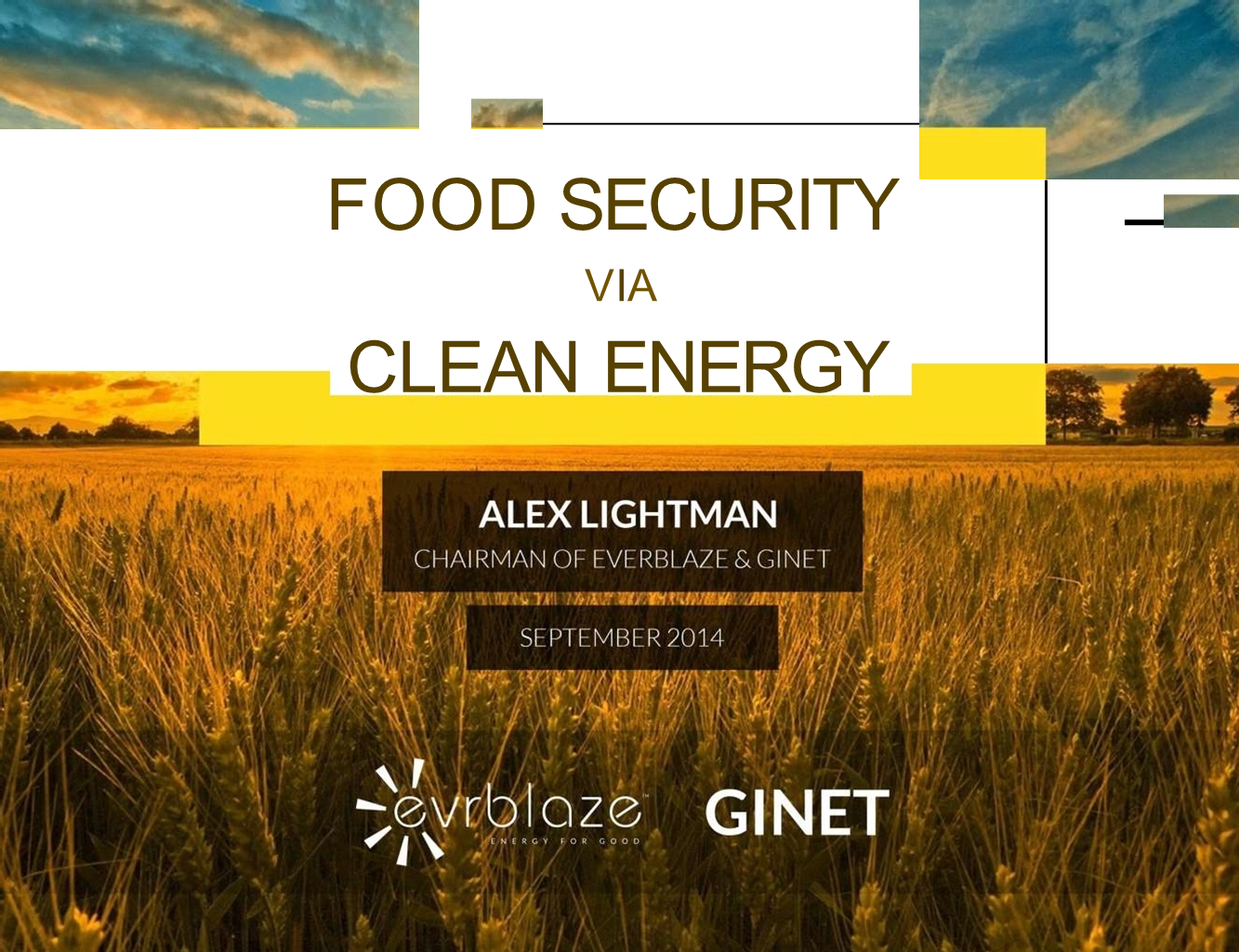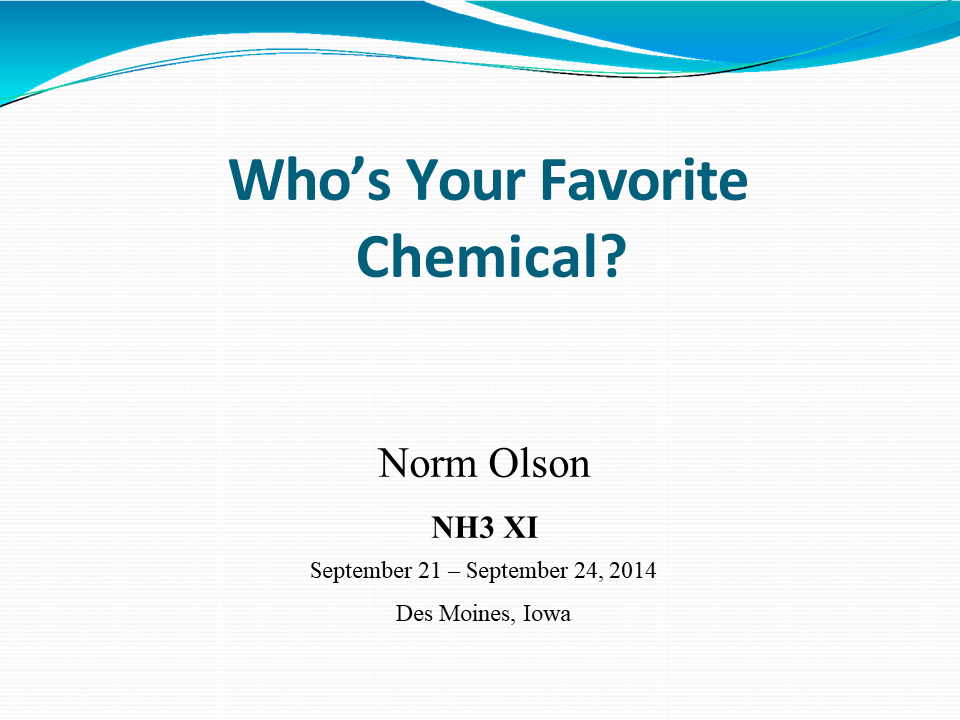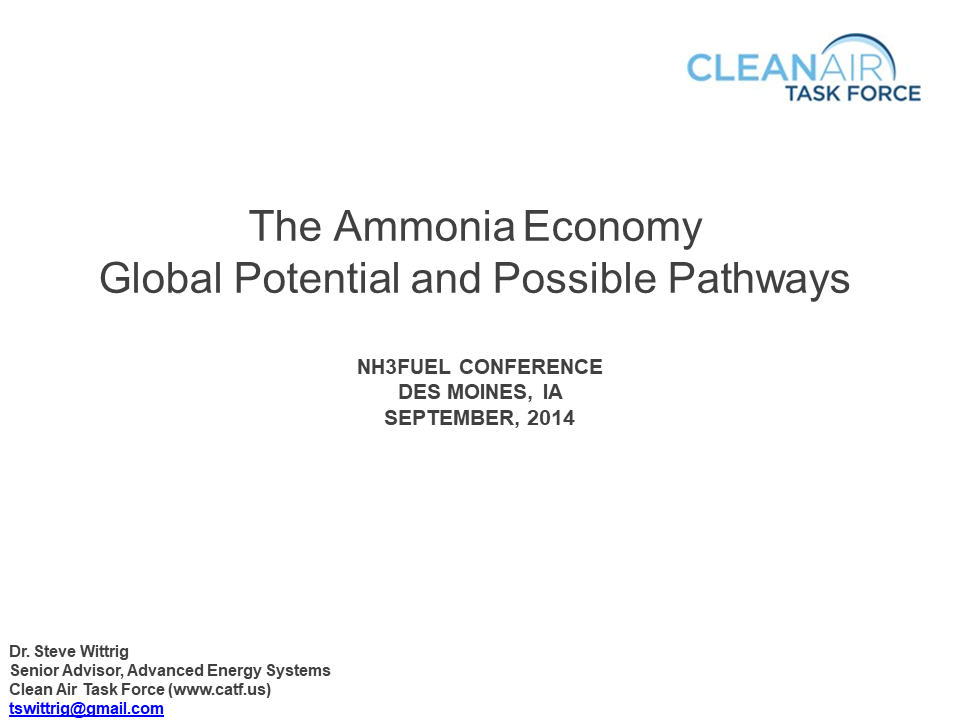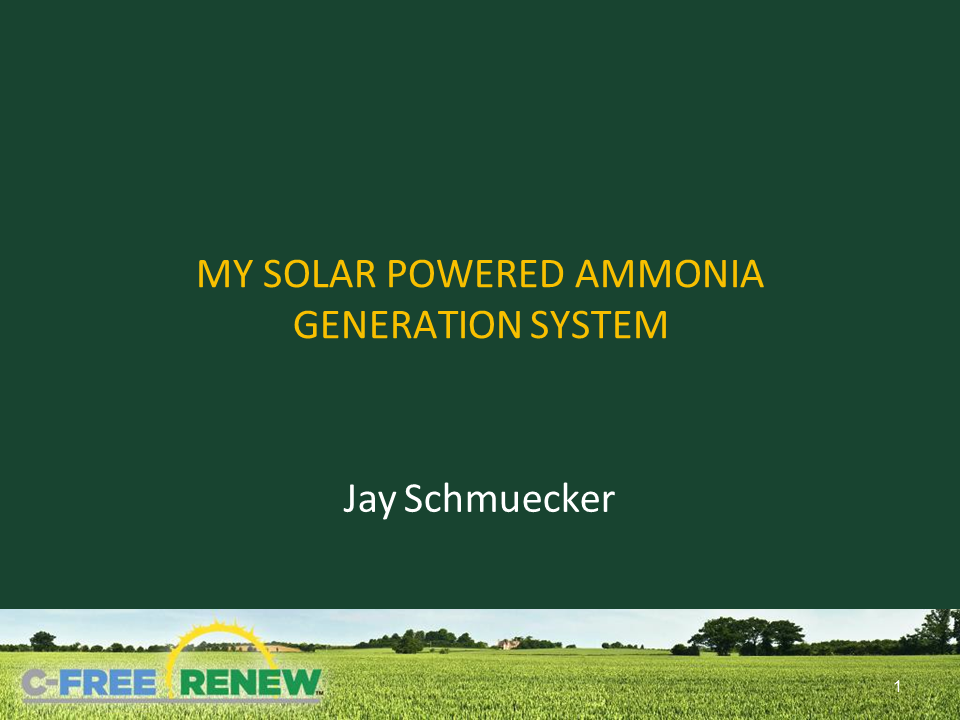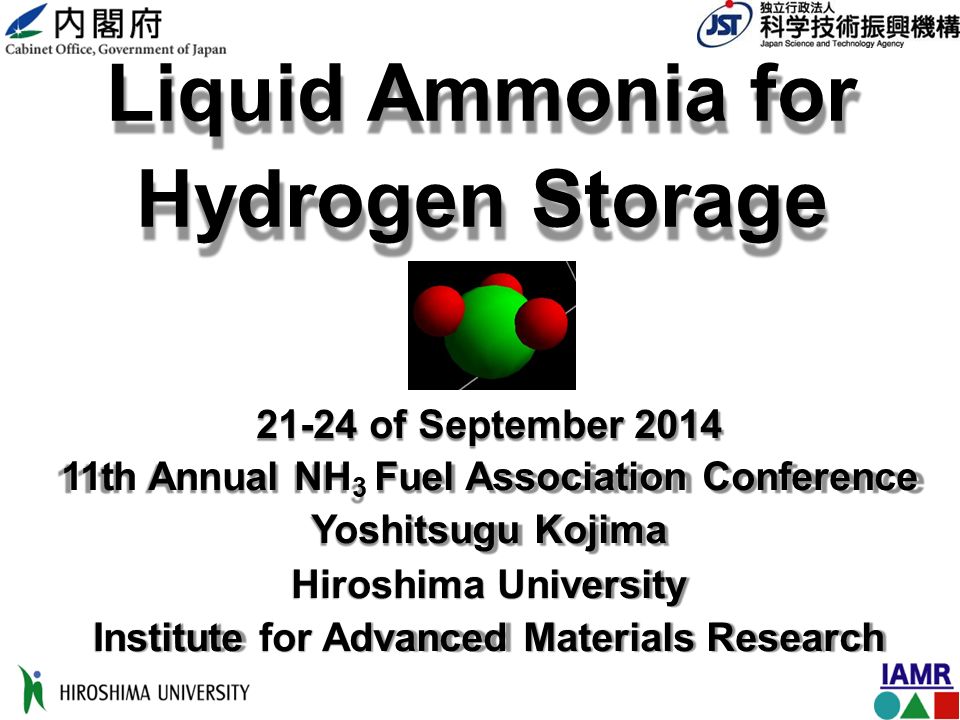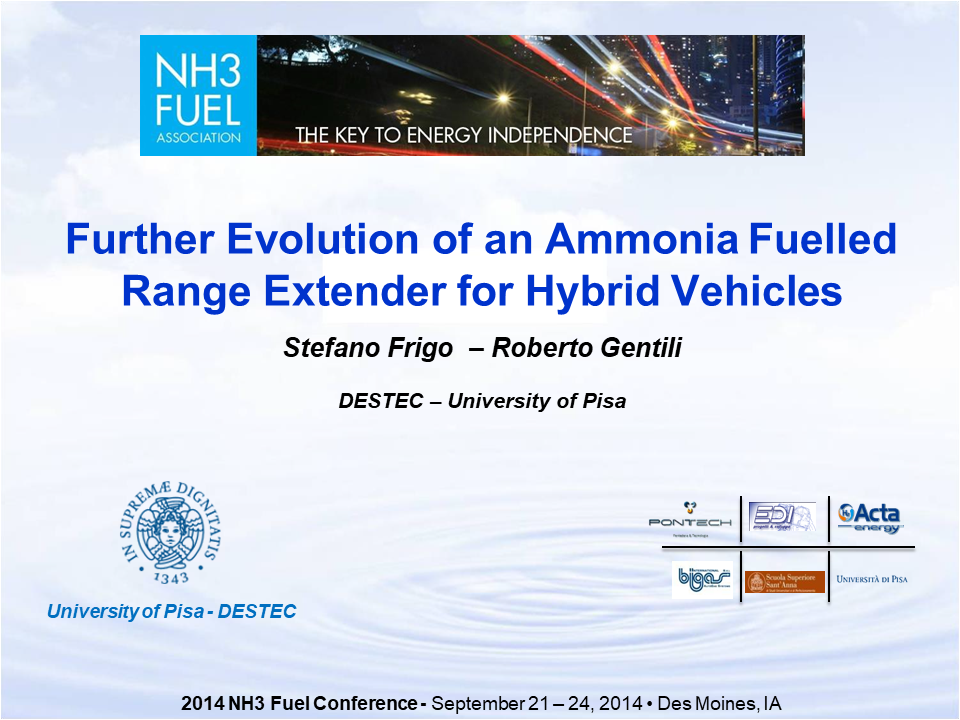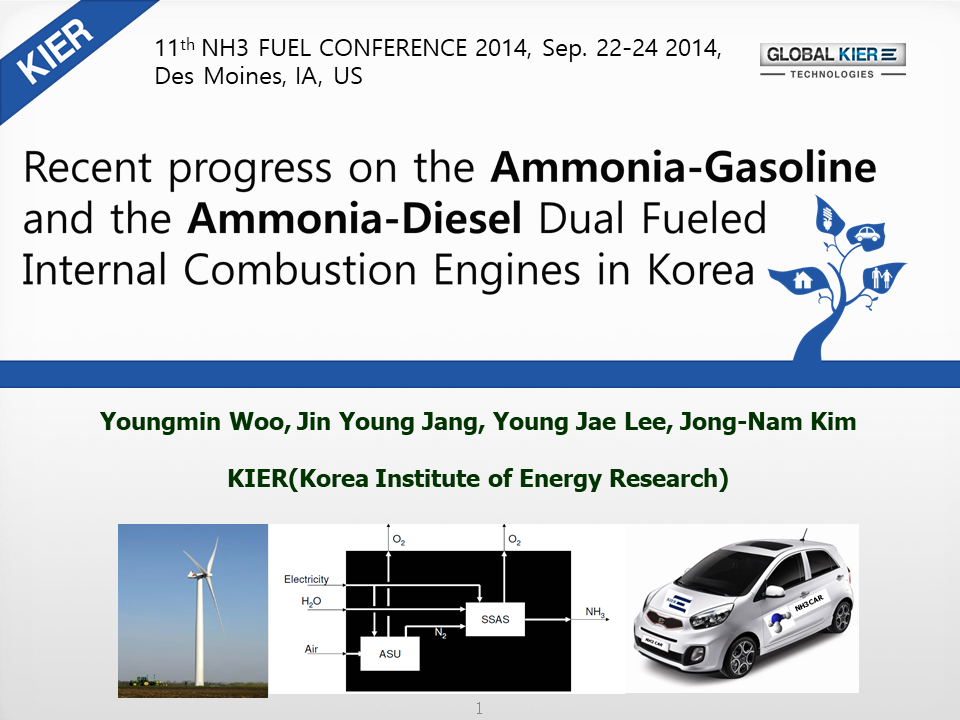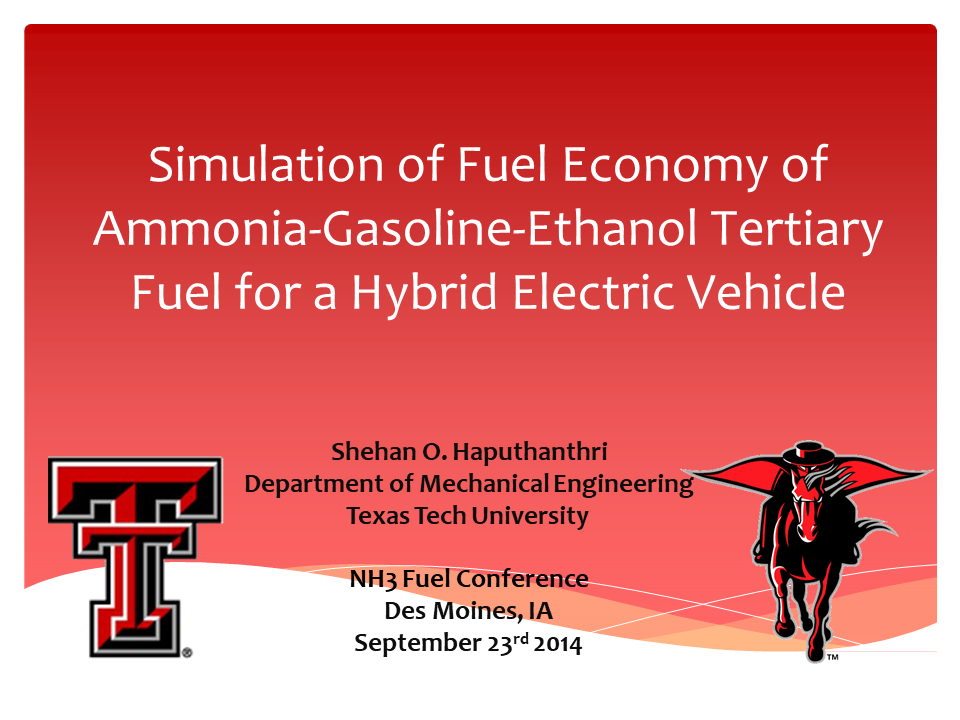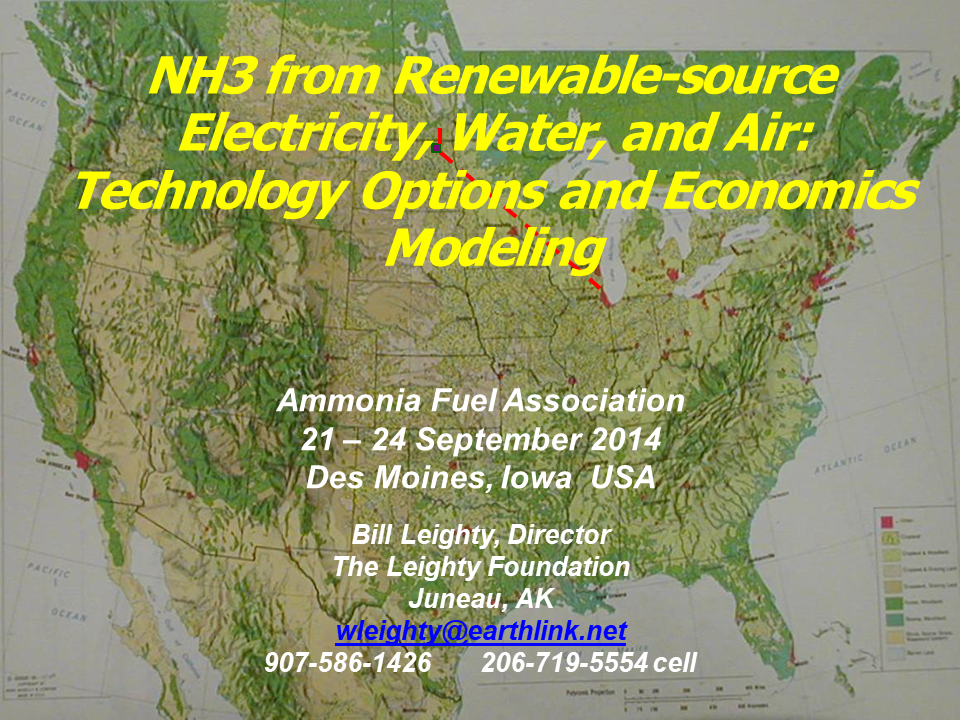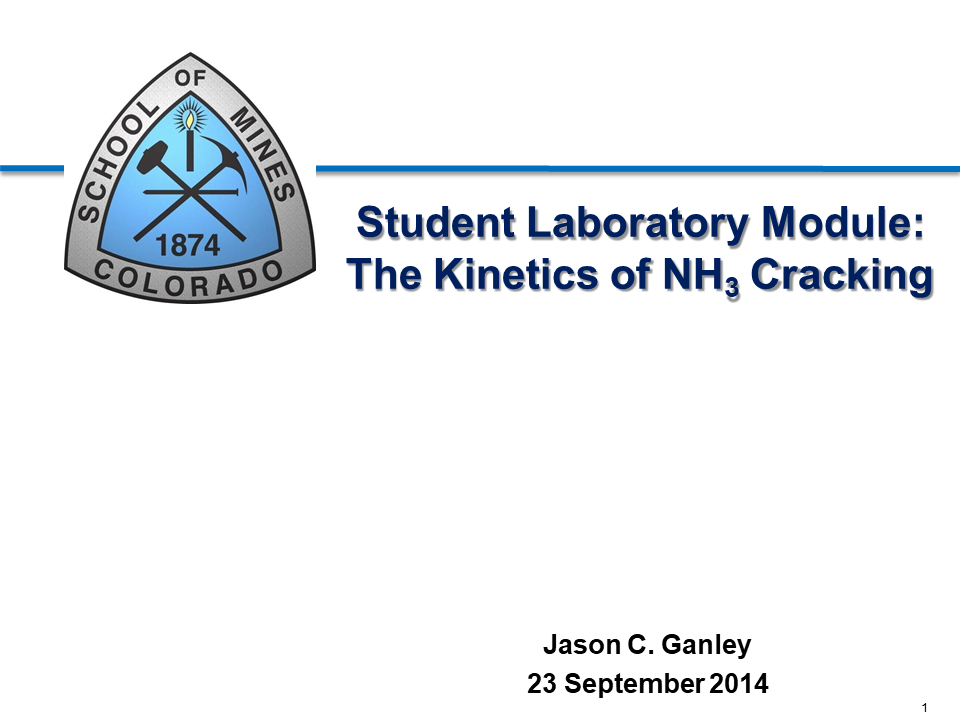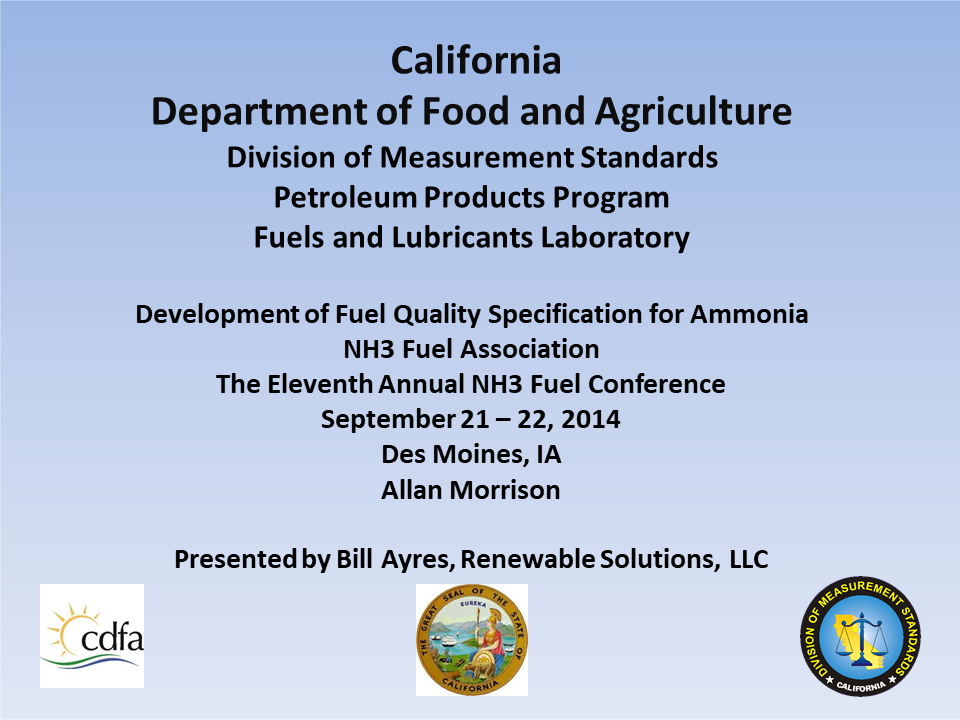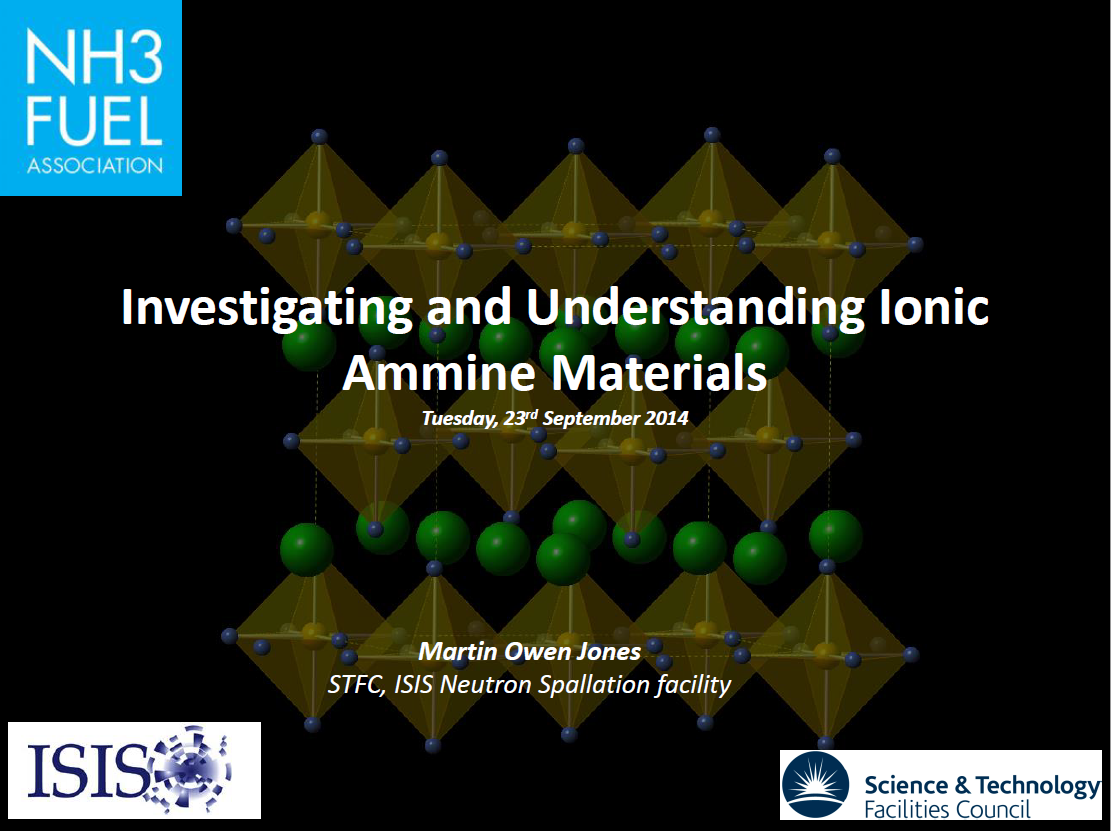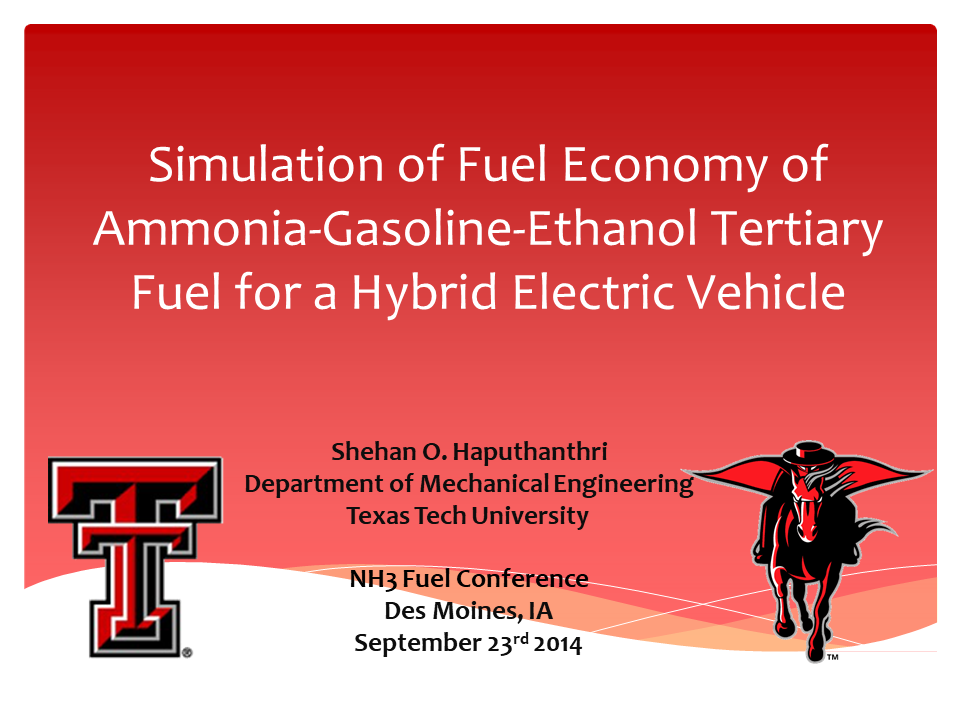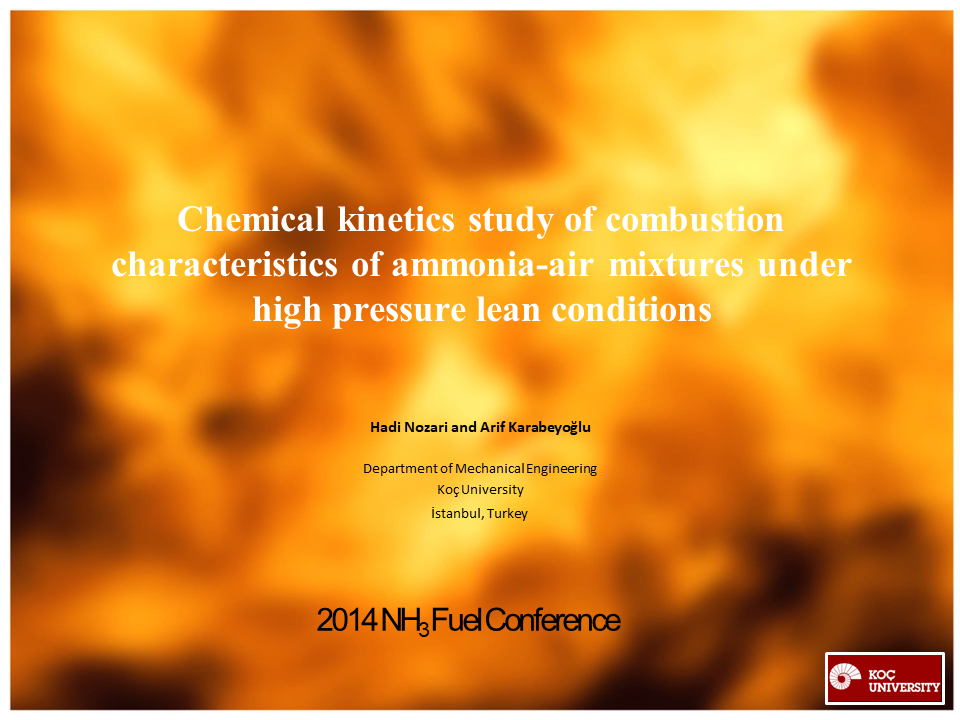NH3 Fuel Conference 2014
September 21, 2014 September 24, 2014 Science Center of Iowa Des Moines United States
21 – 24 September
Schedule
Day One 2014 Conference
Monday, September 22, 2014
Presentation
Green Ammonia to Fuel International Security
Ammonia has the potential to play an increasing role in international security for the US and its allies in global areas of interest. So far, analysis of ammonia for the US government and military has narrowly focused on its use as fuel for combat vehicles, including aircraft or ships, but there are far more vital roles it can play, to save resources and lives.
Presentation
Food Security via Clean Energy
The talk will show why food security is as important as national security, and how the transition from brown NH3 to green NH3 (produced with renewable energy and without carbon) is necessary for food security. This transition will set the stage for green NH3 to be used for energy storage and then a fuel source.
Presentation
Who's your Favorite Chemical?
This paper provides an overview of the impressive attributes of NH3 as a fuel. NH3 is the closet thing to an ideal fuel due to its production flexibility, competitive cost, infrastructure cost/availability, efficiency, environmental performance, and safety. This year’s presentation will emphasize why NH3 is the best bridge fuel between fossil and renewable fuels and why it is relatively simple to make NH3 safe enough to meet the most stringent fuel safety standards.
Presentation
Ammonia Economy – The Global Potential
The development of the ammonia economy will depend on successful deployment of a range of new technologies in the context of the existing ammonia industry and the world’s many existing energy markets. This report will provide framework on: Supply/demand and status of the global ammonia industry. Plausible response of growth and prices in response to a giant new market in fuels. New incremental applications which may lead to ‘disruptive innovation’ and rapid takeoff for ammonia fuels. Barriers to takeoff.
Presentation
My Solar Powered Ammonia Generation System
As a memorial to my father I have installed on the farm where he was raised, a demonstration Solar-Hydrogen system that has been producing and compressing hydrogen from solar power for several years. The hydrogen will be used to fuel a tractor which can also be fueled by ammonia. The ammonia was to be purchased until after last year’s conference when I was put in contact with Doug Carpenter, who has a low energy input catalytic method of making ammonia from hydrogen and nitrogen. I will describe the demonstration system that is being installed. It consists of a nitrogen generator…
Presentation
Liquid Ammonia for Hydrogen Storage
Hydrogen storage and transportation technology is essentially necessary to realize hydrogen economy. Hydrogen can be stored in many different forms, as compressed or liquefied hydrogen in tanks, or as hydrogen carriers: a hydrogen-absorbing alloy, metal hydrides with light elements, organic hydrides and carbon-based hydrogen storage materials. Among them, solid-state hydrides with light elements such as MgH2, Mg(BH4)2 and NH3BH3 possess high hydrogen capacity, 7-20 mass%, However, the practical volumetric H2 density is below 8 kgH2/100L because the packing ratio is down to 50%. Ammonia is easily liquefied by compression at 1 MPa and 25°C, and has a high volumetric hydrogen…
Presentation
Further Evolution of an Ammonia Fuelled Range Extender for Hybrid Vehicles
In a previous research the possibility to run a small 4-stroke twin-cylinder SI engine of 505 cm3 with ammonia plus hydrogen was demonstrated. Ammonia and hydrogen tanks were utilized to feed the engine while, apart, the suitability of a custom-designed catalytic reactor to produce hydrogen from ammonia with the required flow rate was verified as well. The experimental activity confirmed the need to increase combustion velocity by adding hydrogen to air-ammonia mixture, with energy ratios that mainly depend on load and less on engine speed. The minimum hydrogen to ammonia energy ratio was found below 6% at full load and…
Presentation
Recent progress on the Ammonia-Gasoline and the Ammonia-Diesel Dual Fueled Internal Combustion Engines in Korea
Both a spark ignition engine and a compression ignition engine are considered to use ammonia as primary fuel in this study. First, in a spark ignition engine, an ammonia-gasoline dual fuel system was developed and both ammonia and gasoline are injected separately into the intake manifold in liquid phase. As ammonia burns 1/6 time slower than gasoline, the spark timing is needed to be advanced near 40 degree before top dead center. The test engine showed quite high variation in the power output with ammonia supply more than 70% of the total heat value. As a result, 70% of gasoline…
Presentation
A High Efficiency NH3 fueled Diesel Engine
A High Efficiency NH3 fueled Diesel Engine Eddie Sturman, Sturman Industries, USA
Presentation
Ammonia as an alternate transport fuel: Emulsifiers for gasoline ammonia fuel blends and real time engine performance
Ammonia is a carbon-free solution to energy crisis without strenuous changes to the existing infrastructure. Ammonia and hydrocarbon liquid fuel blends can be used to power existing IC engines as an alternative transportation fuel. Due to the structure of ammonia and hydrocarbon molecules an emulsifying agent has to be used to obtain a stable and high molality solution. Feasibility of ammonia and gasoline liquid fuel blends using ethanol and methanol as emulsifiers was studied in this research. A small thermo-stated vapor liquid equilibrium (VLE) high pressure cell was used to study the solubility of ammonia in gasoline. A larger VLE…
Presentation
Micro Gas Turbine Operation with Kerosene and Ammonia
Norihiko IkiOsamu KurataTakayuki MatsunumaTakahiro InoueMasato SuzukiTaku TsujimuraHirohide Furutani
A demonstration test with the aim to show the potential of ammonia-fired power plant is planned using a micro gas turbine. 50kW class turbine system firing kerosene is selected as a base model. A standard combustor is replaced with a prototype combustor which enables a bi-fuel supply of kerosene and ammonia gas. Diffusion combustion is employed to the prototype combustor due to its flame stability. Demonstration test of co-firing of kerosene and ammonia gas was achieved to check the functionality of the each component of the micro gas turbine. The gas turbine started firing kerosene and increased its electric power…
Day Two 2014 Conference
Tuesday, September 23, 2014
Presentation
Effects of cathodic materials on the electrochemical ammonia synthesis from water and nitrogen in molten salts at atmospheric pressure
Electrochemical synthesis of ammonia from water and nitrogen at atmospheric pressure could be an alternative to the current ammonia synthesis process (i.e. Harbor-Bosch) and solve the inherent problems of the process including its high energy consumption and greenhouse gas emission. This study reports electrochemical ammonia synthesis from water and nitrogen in molten salts at atmospheric pressure and temperatures exceeding 623K. Modifications on surface materials of the nitrogen activation electrode were made, tested, and their ammonia synthesis rates were compared.
Presentation
NH3 from Renewable-source Electricity, Water, and Air: Technology Options and Economics Modeling
Our company, Alaska Applied Sciences, Inc. has developed a simple cost modeling tool based on capital recovery factor (CRF), for a client, to analyze, “Under what conditions will the technology in question produce NH3, at a plant gate cost competitive with NH3 from extant sources, from renewable-source electricity, water, and air?” We will report the results of several case assumptions based on Electrolysis plus Haber-Bosch technology. We will also present a catalog of apparently credible technologies for synthesizing NH3 from renewables-source electricity, water, and air.
Presentation
Using Renewable Energy to Produce NH3
Commercial production of Ammonia (NH3) is a large scale industrial process converting natural gas (or other fossil fuels) into gaseous hydrogen, which is catalytically reacted with nitrogen to form anhydrous liquid NH3. NH3 made from natural gas is responsible for approximately 5% of global natural gas consumption (around 2% of world energy). Hydrogen can be produced more simply and more sustainably by the electrolysis of water using renewable electricity. Thus decoupling NH3 production from fossil fuels and substantially decarbonising the process. This provides a means of utilising intermittent renewable electrical power to produce NH3 for use as a fertilizer, fuel…
Presentation
Student Laboratory Module: Kinetics of Ammonia Cracking
The Chemical and Biological Engineering (CBE) Department at the Colorado School of Mines is dedicated to the continual improvement of the laboratory resources made available to those undergraduates enrolled in courses which have major or minor laboratory components. One such course is Kinetics and Reaction Engineering (CBEN 418), offered to undergraduate seniors in the CBE department. Historically, this course has been delivered primarily as a series of traditional classroom lectures with an experimental module (usually one week at the end of the semester) with about 2 hours of participation time per student outside of normal class hours. Previous experimental designs…
Presentation
A novel approach to ammonia decomposition
This talk discusses a new type of process for the cracking of ammonia (NH3) that is an alternative to the use of rare or transition metal catalysts. Effecting the decomposition of NH3 using the concurrent stoichiometric decomposition and regeneration of sodium amide (NaNH2) via sodium metal (Na), this represents a significant departure in reaction mechanism compared with traditional surface catalysts. In variable-temperature NH3 decomposition experiments, using a simple flow reactor, the Na/NaNH2 system shows superior performance to supported nickel and ruthenium catalysts, reaching 99.2% decomposition efficiency with 0.5 g of NaNH2 in a 60 sccm NH3 flow at 530 °C.…
Presentation
Life-cycle greenhouse gas and energy balance of community-scale wind powered ammonia production
As well as being an innovative energy source, ammonia is a crucial component of most nitrogen fertilizers. Since the production of ammonia is very energy intensive and currently completely based on fossil energy, there is a considerable interest in developing renewably produced ammonia for use in agriculture and other sectors. This work presents a life cycle assessment (cradle-to-gate) of greenhouse gas (GHG) emissions and primary energy use for ammonia produced at community-scale using renewable wind generated electricity. Two different regions were studied: Minnesota (US) and Sweden. The results show that ammonia produced with wind-generated electricity has significantly lower fossil energy…
Presentation
Development of Fuel Quality Specification for Ammonia when used as a Motor Vehicle Fuel
A presentation on the steps needed to start the process of developing an ASTM specification for Ammonia when used as a motor vehicle fuel. What does standard consist of? Minimum quality, harmful contaminants, storage, handling, and safety concerns. The need to indentify or develop standardized test methods. The need for participation by producers (production & distribution), users (OEM’s), general interest groups (government, testing labs), and consumers (fleet owners). Appropriate committee: ASTM, SAE or ISO. Timeframe and hurdles. Volunteers to form an exploratory committee. Discussions? Plans to update the group at the 2015 NH3 Fuel Conference.
Presentation
Investigating and Understanding Ionic Ammine Materials
Ammonia has been promoted as a viable candidate as an indirect hydrogen fuel vector, due to its high hydrogen content (17.8 wt%) and its ability to store 30% more energy per liquid volume than liquid hydrogen [1]. Ammonia can be safely stored in very high gravimetric and volumetric density in solid state halide materials [2-3], for example, at 109 gL-1 for Mg(NH3)6Cl2 compared to 108 gL-1 for liquid ammonia. These solid state ammonia coordination complexes, known as ammines, have attracted much recent attention (for examples see [4-5] and references there within) with a view to their use as solid state…
Presentation
Research and development of NH3-fueled solid-state fuel cell systems
Hiroki MuroyamaJun YangKaname OkuraTakeou OkanishiToshiaki MatsuiMotohiro SaitoHiroshi IwaiHideo YoshidaKoichi Eguchi
Ammonia is a prospective carbon-free fuel source for fuel cell systems due to low production cost, ease in liquefaction at ambient temperatures, and high energy density. Furthermore, hydrogen and nitrogen originating from ammonia fuel are expected to have little negative effect on fuel cell performance, while hydrocarbon fuels draws some severe problems at electrodes, such as CO poisoning or carbon deposition in low- and high-temperature fuel cells, respectively. Several technologies can be considered for the ammonia utilization in fuel cell systems. For the utilization of ammonia fuel, we aim to develop a system combined with ammonia decomposition reactor and solid-state…
Presentation
Characteristics of Ammonia / N2 / O2 Laminar Premixed Flame in Oxygen-enriched Condition
The problems of ammonia fuel are a low combustion qualities compared with the combustion qualities of hydrocarbon fossil fuels. In this study, the laminar burning velocity was used as the indicator of the combustion quality. Since the laminar burning velocity of ammonia fuel is low compared with that of other fossil fuels, it is necessary to increase the combustion quality in order to utilize the ammonia as an alternative fuel in conventional combustion systems. In this study, the oxygen-enriched combustion was applied to an ammonia/N2/O2 premixed flame for achieving higher burning velocity. The effects of the oxygen-enriched combustion on the…
Presentation
Fundamental Characteristics of Ammonia/Air Premixed Laminar Flames
Fundamental flame characteristics must be required for the design of ammonia fueled combustors. However, few studies of ammonia combustion have been conducted. In this study, fundamental ammonia/air premixed laminar flame characteristics, such as NO formation/reduction mechanisms and laminar burning velocity, were experimentally and numerically investigated. NO mole fraction in burned gas from ammonia/air premixed flames were investigated using a stainless-steel nozzle burner. Experiments were conducted at various equivalence ratios and pressures. As a result, NO mole fraction in burned gas reduced with the increase in equivalence ratio and pressure. Formation/reduction mechanisms of NO were numerically investigated. Laminar burning velocity and…
Presentation
Simulation of Fuel Economy of Gasoline-Ethanol-Ammonia Tertiary Fuel Blends for a Series Hybrid Electric Vehicle
With the depletion of petroleum resources around the world, a need to have cleaner and fuel efficient automotive technologies and alternative fuel sources has become prominent. Hybrid electric vehicles and sustainable energy sources have gained a high momentum in fulfilling this requirement. To satisfy both needs ammonia, which has been used for a long period of time as a sustainable and carbon free transport fuel can be combined with hybrid electric vehicles. Ammonia when blended with gasoline can be used as an alternate fuel to power existing internal combustion engines. Such blends similar to ethanol-gasoline fuel blends would provide a…
Presentation
Numerical investigation of combustion characteristics of ammonia-air mixtures under high pressure lean conditions
In this numerical study we investigate the combustion characteristics of ammonia-air mixtures at elevated pressure and lean conditions which are encountered in gas turbine combustors. The Konnov mechanism is implemented to predict the laminar burning velocity, autoignition, species concentrations and the sensitivity analysis of ammonia decomposition and laminar flame speed. A laminar premixed freely propagating flame model is implemented to calculate burning velocity, mole fractions of species, and contribution of reactions in molar conversion of specific species. Also a homogenous reactor model is used to analyze the temporal mole fraction of radicals and ignition delay time. Effects of adding hydrogen…

